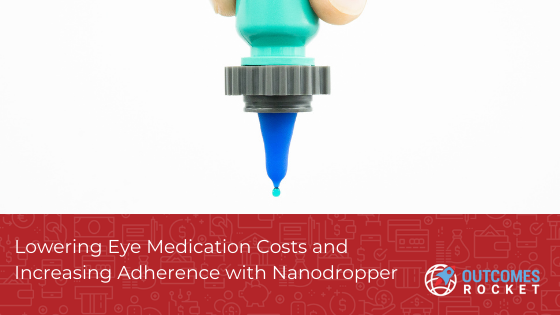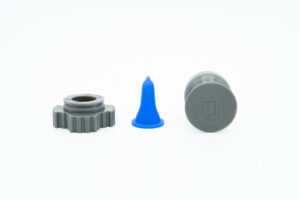
When you think of the estimated $760 to $935 billion annual costs of waste in healthcare, you probably think of causes like unnecessary services, inefficient administrative costs, and expensive drugs, in pill, injectable, and cream forms.
But did you know that most of the eyedrops you take include quite a bit of medication waste? Yes, that tiny bottle is a big part of the problem.
Eye medications, especially for glaucoma, can cost hundreds of dollars per month. For low-income patients and others who are not sufficiently insured, each drop is precious. Though eyedrop bottles are designed to last a month or so, the current design also produces drops that are three to five times too large for the eye to absorb, making it hard for patients to extend the medication for the whole month.
This situation contributes to the waste of medication and increases the risk of medication non-adherence. For patients, it means they are not getting the most out of their money.
Now, there is a solution to this problem — the Nanodropper.
Nanodropper is an adaptor for eyedrop bottles that reduces the drop to a size the eye can actually absorb.
The company was co-founded by Allisa Song, Mackenzie Andrews, Dr. Jennifer Steger, and Elias Baker. The team got their inspiration from a ProPublica article published in NPR about eyedrops being too big and how that’s adding to medical waste. The four of them got to work and invented the adaptor, which is now an FDA-listed, Class 1 sterile medical device made in the U.S.

In our interview with Mackenzie Andrews, Nanodropper’s Chief Commercialization Officer, and Dr. Jennifer Steger, Chief Scientific Officer, they explained that Nanodropper makes drops about two thirds smaller than their current size.
The smaller drops reduce the waste of medication, saves money for patients, extends the use of a bottle, and improves adherence to treatment.

Nanodropper’s innovative cap has a base designed for easy installation. It fits most medicated eyedrop bottles, so patients can just remove the cap of the bottle they are using and attach the Nanodropper. The tip is elongated so you can hold the bottle further from the eye but still ensure precise targeting when it comes to administering the drop. Nanodropper also offers matching stickers for the Nanodropper and bottle to make sure patients know which class of medication it is (i.e. yellow equals beta-blockers, dark blue equals beta-blocker combos, etc.).
According to Dr. Steger, the human eye can only absorb a certain amount of liquid, about 7 to 10 microliters. The Nanodropper’s smaller drops (about 10 microliters) stay in the eye, unlike the large drops which spill on the cheeks or side of the eyes. With a smaller drop, the eye receives just the right amount of medication it can absorb, reducing waste and side effects that come from systemic absorption.
Smaller drops also mean more doses for patients and longer bottle use. Now patients with financial barriers won’t have to worry as much about running out of eye medication fast. That’s a great value for patients.
Another important benefit of smaller drops is reduction in the unwanted side effects of these medications.
Dr. Steger explained that the human eye can only absorb a certain amount of fluid — the excess either spills out of your eye onto your cheeks and rolls down your face, or it’s absorbed through the tear ducts into the body where it can circulate systemically as if it were administered through an IV. With medications like those used to treat glaucoma, systemic absorption of the medication can actually result in some pretty deleterious side effects, including negative effects on your heart and lung function.
Eyedrops like beta-blockers reduce heart rate and blood pressure and can be really problematic for people with undiagnosed heart conditions or lung conditions.
It’s amazing how such a small medication can be a source of problems in healthcare. Large eyedrops result in a waste of money and product, but Nanodropper delivers an effective solution that can be used by both patients and doctors.
When Nanodropper was launched in 2018, it began winning a number of awards, including an Air Force SBIR Phase 1 contract worth $49,000 through the AFWERX program. In 2020, Nanodropper was awarded the SBIR Phase II contract worth roughly $500,000.
With the support of grants and award winnings from major institutions, the Nanodropper team plans to reach more people, collect clinical data, and launch more programs that can help provide access to care for low-income individuals. They’ve recently launched their Give the Gift of Vision program, allowing customers to donate Nanodropper adaptors to those in need.
Learn more about Nanodropper and listen to my podcast interview with
Jennifer and Mackenzie here: https://outcomesrocket.health/nanodropper/2021/02/
According to the 2020 Centers for Disease Control and Prevention report, roughly 34.2 million Americans have diabetes,...
Read MoreAs a farmer, Rod was used to long days. He worked 18 hours a day, 7 days...
Read MoreWith investors receiving hundreds of pitch decks every year, how do you create a compelling presentation that...
Read More
Brittany Busse Co-Founder, President, and Chief Medical Officer at
ViTelHealth


Stephen Thorne Founder and CEO at
Pacific Dental Services

Keith Carlson Nurse Career Coach